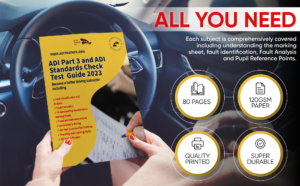Was the trainer aware of the surroundings and the pupil’s actions?
Were you looking in the right place at the right time?
Remember this is in the adi part 3 risk management category.
Did you see what was happening around you?
Did you see what the pupil did OR didn’t do? Did you see it early enough?
The most common sign you were not looking is when you ask the pupil, “Did you check your mirrors then?”
You shouldn’t need to ask – If you are watching the pupil, you should already know and be able to say it as a statement of fact.
Blindspot checks?, not relying on mirrors alone?, and looking AT your pupil.
This is fairly self-explanatory.
But notice there are 2 parts to this
FIRST - Were directions clear and given in good time
Directions
Are they clear and concise – For a newer pupil to say At the roundabout take the third exit – Is that straight ahead third exit, right 3rd exit? – Unless you are working on road markings and signs it is more likely to cause confusion for the pupil.
Or of course suddenly shouting turn left here!! And then telling the pupil that they didn’t do the MSPSL routine!
Second - Were the Instructions clear and given in good time?
To say to a pupils check the mirrors or Dont forget to do mirror, mirror - isn't clear - do you mean centre and left or centre and right?
"Steer!!" - Do you mean turn the wheel a quarter of a turn, half a turn, do you want me to think of it as a clock and steer 10 oclock, 2 oclock 12 o'clock - what is it that you actually mean?
A great way to work on this is by recording yourself and listening back to it. It is amazing what people think they say.
Remember pupils will often need a couple of extra seconds to think which is left and which is right
Was any verbal or physical intervention by the trainer timely and appropriate?
Remember that your first dual control is your voice, then ANY actions.
Interventions must occur if they are needed, and should be suitably timed.
If they occur should be explained and discussed
Or do you find yourself hitting the dual controls first and then saying "Slow Down"
If this is the case, then your commentary may be lacking or you are not managing the risk far enough ahead
ADI PART 3 RISK MANAGEMENT
Was sufficient feedback given to help the pupil understand any potential safety critical incidents?
In short, if this was what you would class as a serious fault, one where you would have failed your Adi part 2 or the pupil would have failed there driving test, then you need to pull them up and talk about it.
Don't try and say it whilst on the move, the pupil is concentrating on driving and will just mentally switch your voice off.
Forget the 40 minutes wheels moving, if what they did would have caused themselves or another road user a serious problem, you need to pull up and discuss it!!
Then find out -
Does the pupil understand what happened?
Do you as the trainer understand why it happened?
Does the pupil understand what action the trainer took and why?
Does the pupil understand the consequences and potential outcomes of what happened?
ADI PART 3 RISK MANAGEMENT

